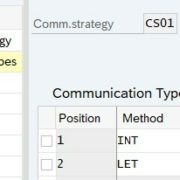What is SAP Fiori?
SAP Fiori – the SAP Fiori architecture is SAP’s new approach to renewing the user experience and updating professional functions for companies. This is more than just a technology. Rather, it is a completely new concept, with design in the foreground. Basically, you could also say that Fiori programs are UX-driven apps. These apps are equally suitable for desktop, PC tablet and smartphones.
According to SAP, each new product is converted to the modern design of SAP Fiori. The goal is to provide SAP users with a consistent, end-to-end experience. By the beginning of 2019, more than 10,000 SAP Fiori apps were already available. According to SAP, Fiori is intended to reduce the cost of business app development by more than 80%.

SAP Fiori
How did SAP Fiori come into being?
Basically, THE experience gained by SAP in recent decades has laid the foundation for Fiori. These experiences have been incorporated into a set of rules. The first 25 apps were introduced at Sapphire 2013.
SAP Fiori 1.0 – In 2013, SAP implemented the first 25 applications. Soon after, more apps followed. As a result, the number of features available to end users has gradually expanded. If SAP HANA is available in the system, analytical applications can be used.
SAP Fiori 2.0 – In October 2016, S/4HANA 1610 was delivered with a completely revised SAP Fiori 2.0. Although this was previously possible through customization, SAP Fiori now automatically adds thousands of classic applications. With Fiori Elements and Fiori for iOS, new opportunities for SAP Fiori application development arose, which were improved in the following years. In October 2018, the new SAP Fiori 3 design was introduced. But unlike the previous version, SAP didn’t deliver everything at once. SAP takes a step-by-step approach to deliver SAP Fiori 3 innovations.
SAP Fiori 3 – SAP has defined Fiori 3 in collaboration with all product areas. Fiori 2.0 was used to examine what needs to be added to support all these product areas in the best possible way. One of the most popular new aspects is the ability to provide more information on the homepage, which is made possible with the design through maps. In addition, SAP is redefining the use of intelligence such as natural language interaction and artificial intelligence as a core component of the customer experience and deeply integrating these components into the design foundation to achieve:
- A smart home page that displays all content related to the user.
- Voice assistant, fully integrated voice control user experience
- Dynamic content to support intelligent applications with embedded artificial intelligence (AI).
- Actively deal with business situations through explanations, insights and suggestions for action.
- The new theme brings a fresh and modern visual appearance.
- Improved search preview, results page, and result visualization.
- A central inbox with a built-in voice assistant.
- The goal of SAP Fiori 3 is to provide an exceptional and intelligent suite that fully supports UX management.
SAP Fiori Design Guidelines
What are the main principles of Fiori applications? The SAP surveys and subsequent analyses have resulted in five central rules for the future design of applications. Applications based on this concept must be role-based, adaptable, simple, consistent, and engaging. Since February 2019, another important component has been added to the principles of its principles. Discussed support for a Conversational User Experience.
SAP Fiori Launchpad
What is the Fiori Launchpad?
The Fiori Launchpad is the central tool for managing, displaying and operating the apps. The Launchpad is, so to speak, Fiori’s frame application. It can be used with the following clients: Web Browser, SAP Fiori Client and SAP Business Client. Important Fiori transactions are:
Fiori Launchpad Transactions
- SAP Fiori Launchpad – Transaction: /UI2/FLP
- Launchpad Customizing – Transaction: LPD_CUST
- Fiori Lpd. Designer (client over.) – Transaction: /UI2/FLPD_CUST
- Fiori Lpd. Designer (clientabh.) – Transaction: /UI2/FLPD_CONF
- SAP Fiori Launchpad – Checks – Transaction: /UI2/FLC
Concept – The Launchpad home page is the first page the user sees after logging in. It is the entry point for SAP Fiori applications on mobile or desktop devices. The Start screen displays tiles that can be used to launch applications, and may display other information. The page can be personalized. You can add or delete tiles and bundle them into groups. The start page is provided by the SAP Fiori Launchpad. The application uses this homepage and does not design its own homepage.
The application can use the following services provided by the Fiori Launchpad:
- Settings (applications only) – Each application can provide application-specific settings for the Launchpad.
- User Settings – This service provides detailed information about the user who is currently logged in to the application. In addition, it also offers a selection of topics.
- Contact Support – You can use the Contact Support option as a channel for user incidents. Please note that this option is only available if the customer configures the support settings.
- Give feedback – This service allows users to provide feedback on the app. Please note that this option is only available if the customer configures the feedback settings.
- Info (apps only) – This option automatically applies to all apps. It contains technical details about the application.
The Application may use the following services provided by the Fiori Launchpad:
- Login/SSO/Logout – All aspects of logging in and out are handled by the Launchpad. If single sign-on (SS0) is used, no user password is required. When SSO is not used, the Launchpad provides a login screen.
- Save as tile – This service allows users to save a snapshot of the application as a tile on the Launchpad. The tiles highlight the current state of the application.
- Navigation – The SAP Fiori Launchpad handles all navigation between applications.
SAP Fiori Apps
Different types of apps
SAP basically distinguishes between transnational apps, analytical apps and fact sheet apps. All of these apps are developed on the basis of SAPUI5.
- Transactional apps:These apps perform transactional tasks, such as creating an absence request for an employee. They allow SAP users to carry out transactions on mobile devices, tablets or desktop computers. Transactional apps provide simplified views of existing business processes and solutions.
- Analytical apps: Complex figures of organizational units are evaluated and clearly summarized as key figures. The user benefits from graphical and quickly detectable access to the complex numbers. These applications are especially interesting for management.
- Info sheet Apps: These apps are used to represent core business goals or KPIs. Information sheets can only be run on an SAP HANA database. Factsheet and Contextual Navigation – Drill-down functions provide more detailed information about objects. For example, navigate from a job factsheet to individual job components.
The following approaches remain central to SAP Fiori development: OData, Jason, XML, HTML 5, JavaScript and HTTP(S) with rest.
FAQ SAP Fiori Apps
Question: What types of applications are available in SAP Fiori?
Answer: There are transactional and analytical applications as well as fact sheets.
Question: Which SAP technologies are available in each SAP Fiori app?
Answer: SAPUI5 and SAP Gateway are used in every SAP Fiori application.
Question: What types of applications do the SAP Hana database require?
Answer: Analytical applications and fact sheets require the SAP Hana database.
Question: Which applications belong to the SAP Fiori Elements?
Answer: SAP Fiori Elements include Listreport, Object Page, Overview Page, Analytitical List Page, and Worklist.
Question: Which applications are meant by the term Legacy Apps?
Answer: The term Legacy Apps refers to abAP transactions and Web Dynpro ABAP applications.
SAP Fiori Elements
SAP Fiori Elements enable the design of UI patterns and predefined templates for common application patterns. Application developers can use SAP Fiori elements to create SAP Fiori applications based on OData services and annotations without JavaScript Ul encoding. The generated application uses predefined views and controllers that are deployed centrally, eliminating the need for application-specific view instances. The SAPUI5 runtime interprets the metadata and annotations of the underlying OData service and uses the corresponding view of the SAP Fiori application at startup. Predefined views and controllers ensure a consistent UI design for similar applications. In addition, the metadata-driven development model significantly reduces the amount of front-end code for each application, allowing developers to focus on business logic.
No JavaScript UI encoding
Unlike traditional SAPUI5 development, developing Fiori Elements applications does not require detailed JavaScript knowledge. Because JavaScript is a flexible and fully dynamic language, and there is no code validation at compile time, code written in JavaScript is more susceptible to run-time errors. Fiori Elements saves you a lot of work learning, writing, and debugging JavaScript code. This method of developing Fiori apps can also improve your overall quality. The stability and maintainability of Fiori apps, especially if you need a lot of Fiori apps.
Metadata-driven Fiori development method
As you’ve learned from previous courses, Fiori applications are based on OData services that provide back-end logic. The metadata document of each OData service describes the information of the service, including entities and attributes of each entity. The collection, association and all of service consumers. The method developed by Fiori Elements is to add more descriptive descriptions to OData metadata documents. These descriptions not only let consumers know the information of the data, but also how to present the data. We call the description added to the OData metadata document OData Annotation.
Centrally provided templates that cover reporting, analysis and trading scenarios
SAP is responsible for providing templates for Fiori Elements. Each template addresses a common requirement of enterprise applications. Currently, we have list report, overview page and analytical list page for daily reporting, analysis and trading scenarios. SAP will continue to add more templates to make Fiori Elements cover the most common requirements.

Other interesting links on the topic










